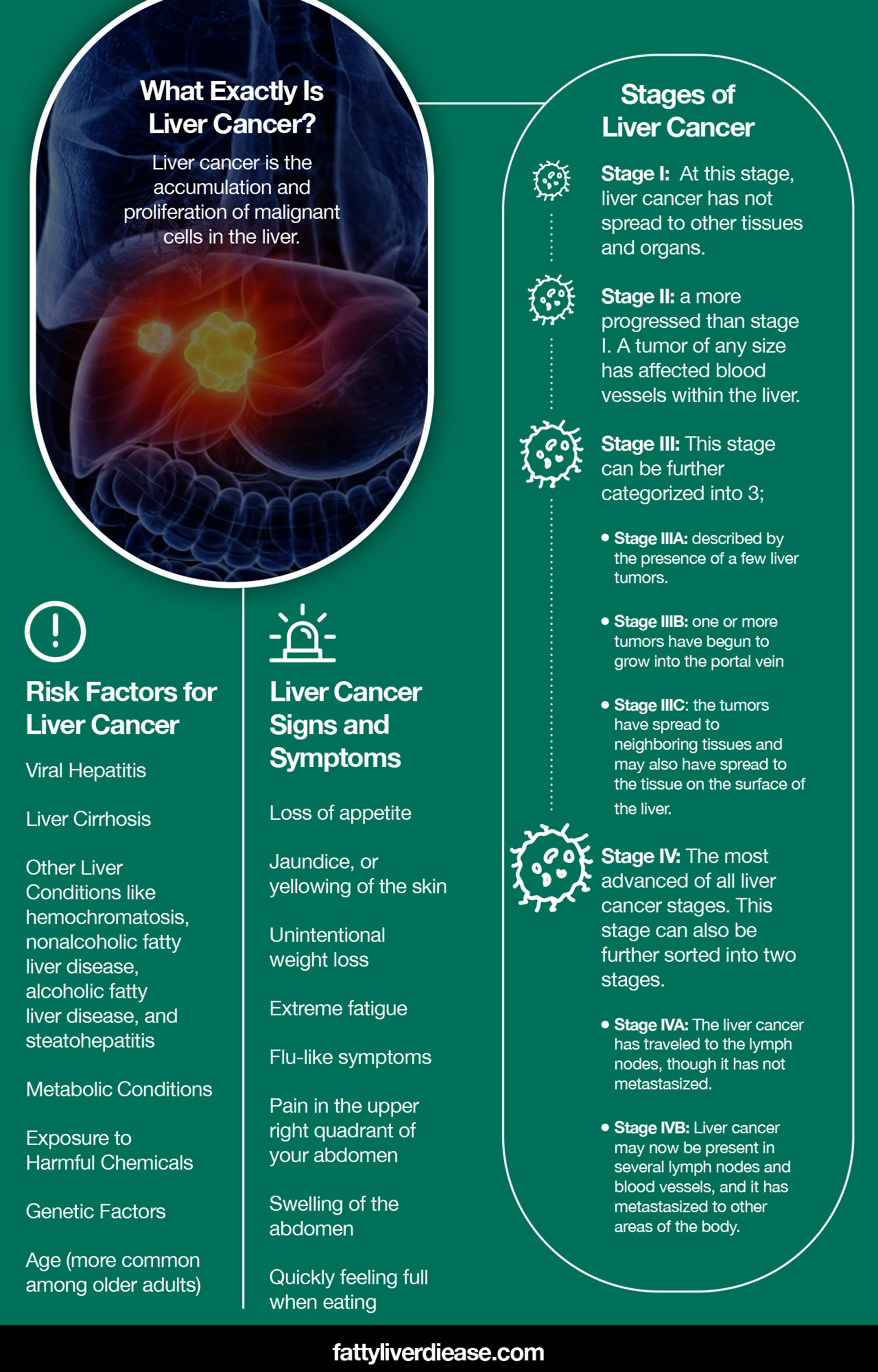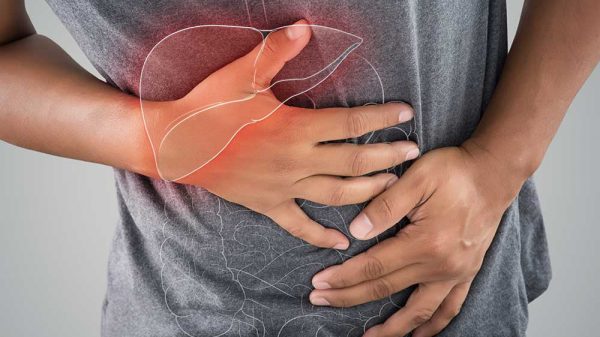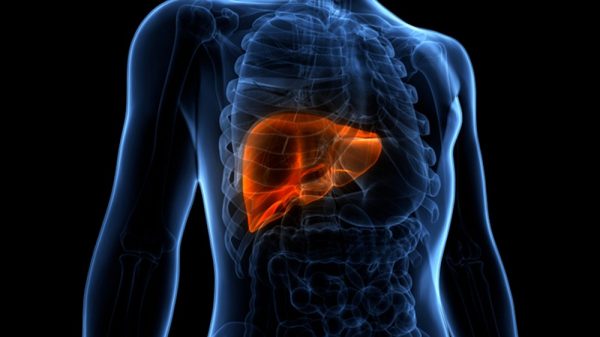Receiving a diagnosis of liver cancer is extremely scary. What does it mean to have liver cancer? What are the stages of liver cancer, and what does treatment look like? One of the keys to navigating liver cancer is being informed.
Let’s go through what you need to know about liver cancer risks, stages of liver cancer, and liver cancer treatment.
What Exactly Is Liver Cancer?
Before we dive into the different liver cancer stages, let’s first discuss what liver cancer is. Liver cancer describes the accumulation and proliferation of malignant cells in the liver.
There are a few different kinds of liver cancer, like cholangiocarcinoma, which is a type of bile duct cancer that can eventually affect the liver, gallbladder, bile duct system, and portal vein. Hemangiosarcoma and angiosarcoma are rare forms of cancer that impact blood vessels within the liver.
Hepatocellular carcinoma (also known as HCC) is the most prevalent type of liver cancer, and is the form of primary liver cancer referred to throughout this article. Hepatocellular carcinoma may arise as a singular tumor that constantly grows. Or, it may arise as smaller growths throughout the liver.
Liver cancer develops when hepatocytes or liver cells develop alterations in their DNA, which is the genetic code that cells have to know how to function. When DNA becomes damaged or mutated, the cells no longer function properly. The body has security mechanisms in the immune system to ensure that damaged cells don’t multiply. However, in the case of cancer, these cells bypass the safety mechanisms and develop into a cancerous mass or tumor.
Cancer of the liver may also originate in another area of the body. This form of liver cancer is called liver metastasis, meaning that another form of cancer has spread or metastasized from other parts of the body to liver tissue.
Liver cancer may also spread to other organs. Cancer that originates in the liver and spreads to other organs is called metastatic liver cancer.
Risk Factors for Liver Cancer
Several factors increase your risk of developing liver cancer. In summary, anything that causes scarring, damage, and inflammation in the liver can increase your risk of developing liver cancer.
Viral Hepatitis
Ongoing infection with viral hepatitis causes serious inflammation within the liver, which leads to a higher probability of DNA undergoing damage and alterations. In particular, chronic hepatitis B or hepatitis C infection can contribute to the risk of liver cirrhosis and liver cancer.
Liver Cirrhosis
Liver cirrhosis results from fibrosis, which describes the accumulation of scar tissue within the liver. A cirrhotic liver is hard in texture, in contrast to the soft texture that characterizes healthy liver tissue. A cirrhotic liver has also lost much of its function due to excessive scarring and damage.
Other Liver Conditions
Having another kind of liver disease tends to increase the risk of developing liver cancer down the road. Genetic conditions like hemochromatosis may also raise the risk of liver cancer. Hemochromatosis is a genetic disorder that impairs normal iron absorption processes, causing excess iron to accumulate throughout the body, including the liver.
Other conditions like nonalcoholic fatty liver disease, alcoholic fatty liver disease, and steatohepatitis should be treated promptly to prevent progression. Over time, fatty liver disease and steatohepatitis may lead to fibrosis and liver cirrhosis.
Metabolic Conditions
Metabolic conditions like type 2 diabetes tend to be associated with a greater risk of developing liver cancer. Interestingly, fatty liver disease is often considered to be a metabolic condition since metabolic dysfunction directly contributes to fat buildup within liver cells.
Exposure to Harmful Chemicals
The liver is responsible for detoxifying and metabolizing all chemicals that we come into contact with, either by inhaling them or consuming them. Certain chemicals are connected to an increased risk of developing liver cancer.
Aflatoxins develop from moldy crops and subsequently manufactured products, and exposure to these toxins over a long period of time is harmful to the liver. Exposure to vinyl chloride and arsenic is also associated with a higher risk of liver cancer.
Genetic Factors
Genetics can influence your likelihood of developing liver cancer. If you have a family history of liver cancer, or you have a parent or sibling who developed liver cancer, then you may also be at a greater risk.
Age
Liver cancer is more common among older adults. As we age, the body’s biological mechanisms get worn out and are more susceptible to cancerous growths.
Stages of Liver Cancer
Now, let’s go through all of the stages of liver cancer. How many stages of liver cancer are there? It’s generally accepted that there are four stages of liver cancer. The lower numbered stages indicate earlier stages of liver cancer, while higher numbered stages represent the most advanced form of liver cancer.
Stage I
Stage I is an early stage of liver cancer and is the least progressed stage. This stage of liver cancer is characterized by a single growth in the liver that has not affected nearby lymph nodes, nearby organs, or the liver’s blood vessels. At this stage, liver cancer has not spread to other tissues and organs.
Stage II
Stage II liver cancer is more progressed than stage I. A tumor of any size has affected blood vessels within the liver. Alternatively, there may be a few smaller tumors, though they should be smaller than 5 centimeters.
Stage III
Stage III liver cancer can be further categorized into stage IIIA, stage IIIB, and stage IIIC.
- Stage IIIA: Stage IIIA is described by the presence of a few liver tumors. At least one of these tumors has grown beyond 5 centimeters. The cancerous growths are contained within the liver and have not metastasized to other areas.
- Stage IIIB: In this stage of liver cancer, one or more tumors have begun to grow into the portal vein, which is the primary vein that supplies the liver with blood. At this point, the liver cancer still has not spread to lymph nodes or other organs.
- Stage IIIC: In stage IIIC of liver cancer, the tumors have spread to neighboring tissues and may also have spread to the tissue on the surface of the liver.
Stage IV
Stage IV is the most advanced of all liver cancer stages. This stage can also be further sorted into two stages.
- Stage IVA: In Stage IVA, liver cancer has traveled to the lymph nodes, though it has not metastasized.
- Stage IVB: Liver cancer may now be present in several lymph nodes and blood vessels, and it has metastasized to other areas of the body, such as the bones and lungs.
Other Forms of Liver Cancer Staging
The Barcelona Clinic Liver Cancer (BCLC) system and TNM system are other methods that physicians use to evaluate the exact status of your liver cancer, how it impacts liver function, and whether it has metastasized to other organs.
The BCLC staging system provides a method for physicians to evaluate a cancerous growth based on its size, symptoms, impact on the organ, and metastasis.
The TNM system provides a way for physicians to understand how progressed the cancer is and whether it has spread. “T” stands for tumor, “N” stands for nodes, and “M” stands for metastasis, and each area yields valuable information about the state of cancer.
- T: This describes the size and orientation of the cancerous growth in the liver, as well as the possible presence of tumors in surrounding tissues.
- N: This describes whether cancer has affected lymph nodes. When cancerous cells have made their way to lymph nodes, the probability of metastasis is higher.
- M: Metastasis describes the spreading of cancerous cells to distant organs.
It’s important to keep in mind that there is not necessarily one protocol that physicians use over another. Classifying a cancerous growth also tends to be highly individual. So for the most accurate and applicable information, it’s best to talk to your doctor about your particular case.
Liver Cancer Signs and Symptoms
Numerous unpleasant symptoms may accompany liver cancer. Keep in mind that liver cancer may also be asymptomatic, especially during the earlier stages.
- Loss of appetite
- Jaundice, or yellowing of the skin
- Unintentional weight loss
- Extreme fatigue
- Flu-like symptoms
- Pain in the upper right quadrant of your abdomen
- Swelling of the abdomen
- Quickly feeling full when eating
Diagnosing Liver Cancer
Liver cancer is diagnosed using a combination of blood tests, scans, and biopsy results. For hepatocellular carcinoma, elevated levels of alpha-fetoprotein may indicate the presence of liver cancer. However, these results alone are not sufficient for a diagnosis. Magnetic resonance imaging (MRI) scans and computed tomography (CT) scans are useful for determining the size and location of the cancerous growths.
Moreover, your physician will take a biopsy of the growth within your liver. This means a very small sample of the tumor will be examined using a microscope and analyzed for abnormalities consistent with cancer.
A definitive diagnosis is made based on testing and biopsy results, which will be able to reveal whether the tumors present in the liver are cancerous.
Unless you are at particularly high risk for developing liver cancer, regular screening is not recommended.
What You Can Do to Protect Your Liver
There are several steps you can take to look after your liver health and lower your risk of developing liver cancer.
Eat a Healthy Diet
A healthy diet offers a variety of macronutrients and micronutrients that support liver health. Here are a few of the key components of a liver-friendly diet:
- Fruits and veggies: Fruits and veggies are loaded with micronutrients like vitamins, minerals, and antioxidants that protect liver cells from inflammation and oxidative stress. Try incorporating foods like spinach, kale, broccoli, apples, blueberries, and strawberries into your diet.
- Healthy fats: Healthy fats like omega-3 fatty acids are associated with lower levels of inflammation and improved liver health. To get plenty of healthy fats, incorporate foods like chia seeds, flaxseed, pecans, walnuts, salmon, and mackerel into your diet.
- High-quality protein: High-quality protein like lean meat and nonfat dairy provide optimal ratios of essential amino acids. Research shows that essential amino acids are associated with improved liver health, and some may even protect against cancer-causing cellular mechanisms. (1)
Manage Underlying Conditions
If you have underlying conditions that are influencing your liver health, it’s important to get these conditions resolved as soon as possible. For example, if you suffer from viral hepatitis C, it’s crucial to undergo treatment with antiviral medication to get rid of the infection. Eliminating the infection reduces inflammation and damage to liver tissue.
Lose Weight If Necessary
Losing weight is a key part of managing liver disease, especially in the case of nonalcoholic fatty liver disease and nonalcoholic steatohepatitis. Being overweight is associated with metabolic dysfunction like insulin resistance and contributes to the risk of accumulating fat particles in liver tissue. To protect your liver health and reduce the risk of developing liver cancer, lose weight in a healthy way by eating healthy, managing portion sizes, and exercising regularly.
Steer Clear of Alcohol
Alcohol is a serious inflammatory agent for the liver. If you have alcoholic liver disease, it’s especially important to eliminate alcohol completely from your lifestyle. If you are physically dependent on alcohol, contact your doctor and an addiction specialist to determine the best method for detoxing and finding a treatment program that fits your needs.
Eliminating alcohol from your diet is also a good idea if you have other liver conditions, such as hepatitis C or fatty liver disease. Reducing stress on your liver in any way possible will only be helpful in lowering the risk of developing liver cancer.
Treatment Options for Liver Cancer
There are several treatment options available for liver cancer care and treatment. Your team of doctors will decide the most effective course of treatment for your particular case. You will work with an oncologist who specializes in liver cancers, as well as radiologists, your general practitioner, and surgical oncologists to treat and manage your liver cancer and other co-occurring conditions. Here are a few of the possible treatment options that your oncology specialists may recommend:
Surgical Tumor Removal
Your doctor may decide that surgically removing the liver tumor is the best course of action.
Liver Transplant
A liver transplant may be the best treatment option when liver cancer is severely affecting liver function. Can you live without a liver? It is impossible to live without a liver, making liver transplants an extremely valuable treatment for severely diseased livers. A liver transplant involves removing your damaged liver and replacing it with healthy liver tissue from a donor and is the most effective treatment for individuals with end stage liver disease, liver failure, or other conditions that severely compromise liver function.
A living donor or deceased donor may be the source of the healthy liver tissue.
Radiation Therapy or Chemotherapy
Your doctor may recommend radiation or chemotherapy treatments to treat liver cancer. Chemotherapy slows the growth of proliferating cancer cells, and radiation helps decrease tumor size and kill cancer cells. Radiation is often administered only to your liver to minimize damage to other organs and tissues.
Targeted Drug Therapy
Targeted drug therapy involves using drugs that are tailored to your specific case of cancer. Certain cancers have particular genetic traits and exhibit specific mechanisms and activity. Knowledge of these details about how the cancer works allows doctors to identify the cancer cells’ vulnerabilities and administer drugs that decrease the cancer’s activity.
Extreme Heat or Cold
Special treatments exist to deliver extreme heat or cold to the cancer cells. Electricity, microwaves, or laser instruments may be used to apply extreme heat to the liver tumors and kill cancer cells. Alternatively, liquid nitrogen may be used to freeze and kill cancer cells.
Liver Cancer Survival Rates
Liver cancer survival rates depend on many factors, such as how early the cancer is caught, responsiveness to treatments, and liver function. Only your physician will be able to give you an accurate estimation of your prognosis.
End stage liver disease life expectancy varies based on several factors, including the success of the liver transplant and how well the new liver functions.
Conclusion: What Are the Stages of Liver Cancer?
Hepatocellular carcinoma is the most common form of liver cancer. The risk of developing liver cancer is influenced by the presence of liver damage and inflammation connected to alcohol abuse, nonalcoholic fatty liver disease, liver cirrhosis, genetics, and chemical exposure. Doctors can diagnose liver cancer using imaging technology and a biopsy of liver growths, and treatment includes radiation, chemotherapy, surgical removal, targeted therapy, and hot and cold treatments. There are several stages of liver cancer that are categorized based on metastasis and characteristics of the liver tumor. In order to lower the risk of developing liver cancer, it’s important to manage underlying conditions, eat a healthy diet, eliminate alcohol use, and maintain a healthy weight.

References:























